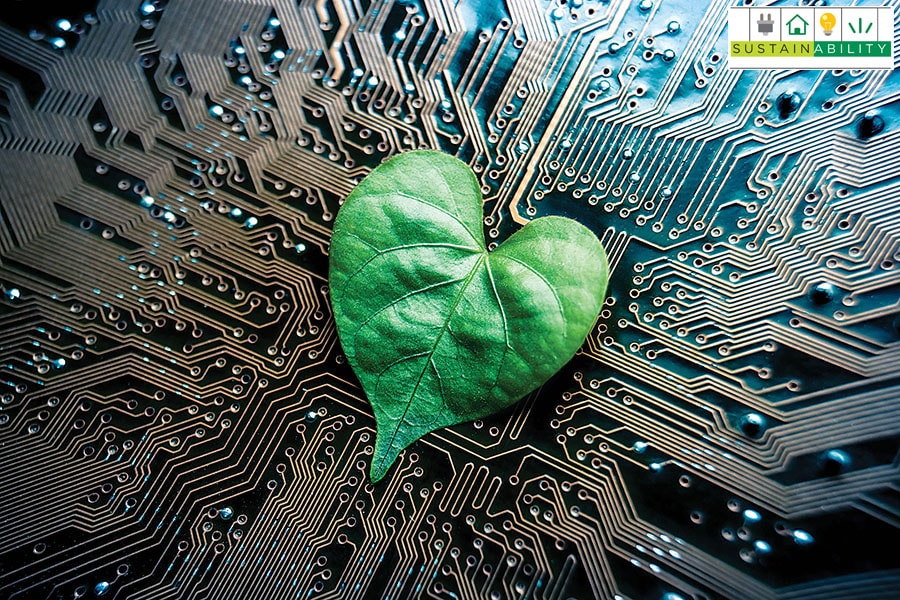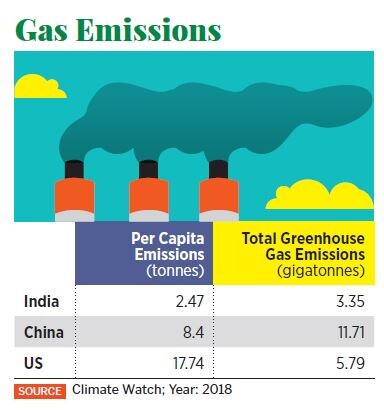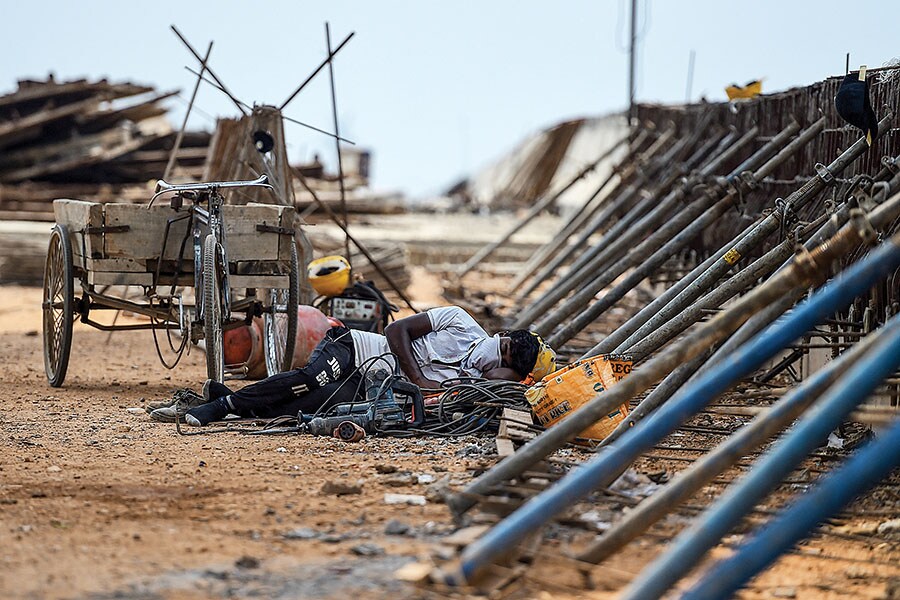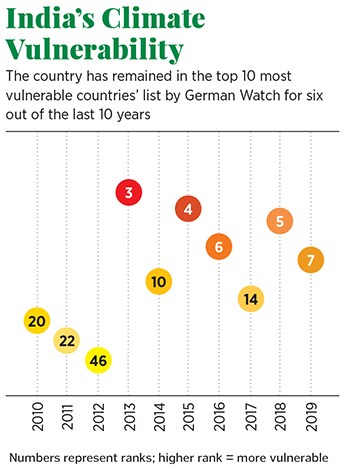Industrial revolutions have gone down in history as milestones of human progress. Strong and efficient industries led to robust economies, wealth creation, scientific and technology prowess, better education, as well as more opportunities to succeed. Today, the world was able to come up with not just one but multiple Covid-19 vaccines in record time.
A little known by-product of the first industrial revolution was environmentalism. “It was the first time that people had started living in concentrated cities, and they were getting sick like they had never been before as industries contaminated the air and water," explains Mike Rosenberg, author, Strategy and Sustainability, and professor of the Practice of Management in Strategic Management Department, IESE Business School.
Every industrial age has made companies more efficient, productive and profitable. The impact of industries on our environment, however, has continued unabated.
The fourth industrial revolution or Industry 4.0—the process of digitisation of everything—has been under way for some time now. And as the world went indoors to stay safe, the Covid-19 pandemic acted as a catalyst for an accelerated shift to digital. Everything from AI-ML to robotic process automation, cloud computing, smart sensors and interconnected machines are making our companies smarter and more efficient. But as millions of dollars are invested into new technologies and as companies look for ways to recoup losses for getting back on the path of growth, there is an economic, competitive, global opportunity for companies that will transition to become sustainable. This will mean assessing and investing in not only their financials and profits, but also on their workforce, environment and community.
![]() “The efficiencies brought about by Industry 4.0 will lead to very limited—about 5 to 10 percent—gain. Today every company has to find ways to expand or grow without increasing environmental impact. Industry 4.0 should be as much about technology as it should be about using sustainable solutions," says Chaitanya Kalia, partner, Climate Change and Sustainability Services Leader, EY India. And there are benefits of being an early adopter. “It’s like a cricket match, like T20 or a one-day international, if you don’t score your runs now, you have to score faster towards the end, and there’s a risk of losing. So, companies have to do it now, have to do more, and have to do it fast so that even the cost of doing everything is controlled."
“The efficiencies brought about by Industry 4.0 will lead to very limited—about 5 to 10 percent—gain. Today every company has to find ways to expand or grow without increasing environmental impact. Industry 4.0 should be as much about technology as it should be about using sustainable solutions," says Chaitanya Kalia, partner, Climate Change and Sustainability Services Leader, EY India. And there are benefits of being an early adopter. “It’s like a cricket match, like T20 or a one-day international, if you don’t score your runs now, you have to score faster towards the end, and there’s a risk of losing. So, companies have to do it now, have to do more, and have to do it fast so that even the cost of doing everything is controlled."
India—land of climate paradoxes
The Covid-19 pandemic was a rude wake-up call for India and the world, however, “it is not even a fraction of what’s going to happen when the climate crisis hits us", says Rahul Munjal, managing director, Hero Future Energies. To avert the next crises, many countries are taking to stricter environmental and socioeconomic regulations.
India’s greenhouse gas (GHG) emissions are the third highest in the world after China and the US. However, due to India being the second most populous country, its per capita emissions—the figures often used by industry and government—are four times lower than China and over eight times lower than the US. “We’re not announcing legally binding [net zero] targets because our position is that our emissions divided by population are less compared to many other countries," says Kalia.
![]() Labour lost to sick days and reduced productivity due to air pollution cost businesses $30 billion: Study
Labour lost to sick days and reduced productivity due to air pollution cost businesses $30 billion: Study
Image: Money Sharma / AFP
Meanwhile, hesitant to stifle growth in a developing economy, many in the industry also opine that India is a poor country, and those who are imposing stringent environmental regulations are developed giants, rich enough to now start cleaning up their mess.
In terms of the impact of climate change events on lives and losses, India has consistently ranked in the top ten countries on the ‘Climate Risk Index’ by German Watch. The country has seen losses of ₹5.61 lakh crore ($79.5 billion) and ₹7.53 lakh crore ($100 billion) in the last two decades, respectively, due to extreme climate events and vector-borne diseases, The United Nations Office for Disaster Risk Reduction estimates. This does not include the economic losses of the Covid-19 crisis.
![]() Last year, Cyclone Amphan displaced 2.5 million people and destroyed 2.8 million homes, leaving millions without a roof during a global pandemic, and led to $14 billion in losses—the costliest tropical cyclone on record for the North Indian Ocean, according to the 2020 World Meteorological report. Amphan’s westerly winds that directed locust swarms from Pakistan into India was the worst attack in 27 years and wiped out crops across 10 Indian states, plunging farmers into deeper financial wells.
Last year, Cyclone Amphan displaced 2.5 million people and destroyed 2.8 million homes, leaving millions without a roof during a global pandemic, and led to $14 billion in losses—the costliest tropical cyclone on record for the North Indian Ocean, according to the 2020 World Meteorological report. Amphan’s westerly winds that directed locust swarms from Pakistan into India was the worst attack in 27 years and wiped out crops across 10 Indian states, plunging farmers into deeper financial wells.
Air pollution led to premature deaths of 1.7 million people in 2019, according to Lancet Planetary Watch. “India is one of the most vulnerable countries to climate change," Arunabha Ghosh, CEO, Council on Energy, Environment and Water (CEEW) said recently, adding that the council’s research showed three-fourths of India’s 700 districts are now hotspots for extreme climate events such as droughts, floods and cyclonic events.
According to a study by CII and Dalberg Advisors, air pollution costs Indian businesses $95 billion or 3.3 percent of India’s GDP every year—labour lost to sick days and reduced productivity cost businesses $30 billion the IT sector loses $1.3 billion due to pollution-induced productivity losses every year, and retail businesses lose $22 billion as customer footfalls reduce when the air quality is bad. “Every year, air pollution costs India’s businesses close to 50 percent of the cost of managing the Covid-19 pandemic. Yet only ₹4,400 crore has been invested to solve air pollution, less than 10 percent of the total outlay on Covid-19 response," the study notes.
![]() Then, solving India’s pollution and greening the economy should be as much or more of a priority for business as it is for governments or the civil society. “Industries cannot take comfort in the narrative that the government will focus on development [while it can focus on profits]. Development and sustainability are not two diverse topics," Shuva Raha, head-New Initiatives, CEEW, tells Forbes India. “Companies and donors are willing to do it to the extent of CSR, but it needs to be done at an industrial scale to create job growth and economic growth, and not as charity."
Then, solving India’s pollution and greening the economy should be as much or more of a priority for business as it is for governments or the civil society. “Industries cannot take comfort in the narrative that the government will focus on development [while it can focus on profits]. Development and sustainability are not two diverse topics," Shuva Raha, head-New Initiatives, CEEW, tells Forbes India. “Companies and donors are willing to do it to the extent of CSR, but it needs to be done at an industrial scale to create job growth and economic growth, and not as charity."
India’s success in the renewable energy sector was thanks to the ambitious targets it set, helping create a new domestic market, green jobs, and changing the country’s energy mix. “India’s [industrial processes] are nowhere near peaking and we don’t have the technology or the wherewithal to peak economically or developmentally, but that doesn’t mean we cannot set a target," says Raha, adding, “We’re in favour of having a net zero target. More importantly, the government should have a scientific pathway to that end. Targets help keep you on track."
Indian companies are woke
Consumers and companies are “woke" today, Munjal says. Every company is aggressively making its sustainability plans and trying to outdo competition, because if rivals beat them to it, customers will flock to them, he says, adding, “Companies have understood they need to be environmentally friendly, and brands are talking about not just being net zero but going negative."
There are many push factors for companies to be sustainable today, apart from millennials and other consumers demanding change. Others are the cost effectiveness of renewable energy—which can help companies save 20 to 25 percent in energy costs. Pressure from global banks, multinationals, foreign institutional investors, and large asset management companies has its hand too.
“It’s not going to be economically viable for companies to not be on the sustainability track. Globally, energy trends are changing, so are emission targets for countries, maritime and aviation trade… these regulations will impact every single entity in the trade," says Raha. Companies need to ask: Are my business processes individually sustainable to be resilient to global changes?
Pratap Raju, founding partner of Climate Collective Foundation, a non-profit building local climate entrepreneurship ecosystems, elucidates that global asset management companies and foreign investment investors “are wielding their clout in the market to push [Indian] companies to be resource efficient and environmentally sensitive." He adds stock markets will play a strong role in ensuring Indian companies follow the direction of the global trends.
![]()
Data centres: The New Carbon Islands
In 2020, with more demand on digital during the pandemic, global data creation and replication (storing multiple copies of the same data for better accessibility) hit 64.2 zettabytes, according to Dave Reinsel, senior vice president, IDC’s Global DataSphere. In a March 2021 statement, he said, “The amount of digital data created over the next five years will be greater than twice the amount of data created since the advent of digital storage."
Global data creation and replication will see a compound annual growth rate (CAGR) of 23 percent between 2020 and 2025. The fastest-growing data segment will be Internet of Things, followed by social media, IDC says.
In India, the booming startup sector has delivered about a dozen unicorns in the first four months of 2021. As the sector grows, along with the digitisation of every business and the increasing government-to-citizen digital services, the data centre market is also growing. These data centres make up the backbone of the digital economy but are also the new carbon and heat islands.
In 2019, data centres alone accounted for one percent of global electricity demand. With the renewables share being low in their energy mix, they further accounted for two percent of the total GHG emissions.
Munjal says Silicon Valley players, home to the biggest internet companies in the world, are the first to move to renewables, and in India, “the change is coming sooner than you know it".
Raha, however, is not so optimistic, as awareness is low. “Most venture capitalists, barring some global ones, only look for return on investment… even the green investors are people who want to multiply their money, so we need regulations and an India-based standard of emissions."
![]() Environmental policies
Environmental policies
India’s disastrous Environmental Impact Assessment draft 2020 was withdrawn for revision after the government received two million emails and letters from civil society and activists.
Coal has underpinned the expansion of electricity generation and industry, and remains the largest single fuel in the mix, India Energy Outlook 2021 report by the International Energy Agency (IEA) notes. India’s energy use has doubled since 2000, with 80 percent of demand still being met by coal, oil and solid biomass. While India is on track to meet its target of setting up 175 gigawatts of renewable energy in the country by 2022, renewables still make up less than one percent of the total energy mix for industries.
Munjal says the government’s ambitious renewables policy allowed pricing and negotiating power for the sector. The need now is for “very strong policy to promote rooftop businesses, apart from standardising net metering, banking and wheeling charges across the country." The government should also delink generation from distribution to enable customers to choose who they want to buy energy from, he adds. “These are very big policy changes and will not happen overnight… Industry 4.0 without these changes will not happen."
However, he also believes, as does EY India’s Kalia, that “encouraging" businesses to do the right thing is enough and one doesn’t need mandates from the government.
“I’m a big believer we have to let market forces decide, let business do what it wants. Business should not be a diktat from the government, it should be because the customer, shareholder and employees want it I want to go down the way that industry is given the right to compete against itself and to decide what is right because of competition," Munjal contends.
EY India’s Kalia believes “we’re a free economy, so if it’s market based, it will be more efficient. If it’s mandatory then it hampers growth".
However, one must consider that allowing market forces to play out is exactly what has brought us to this stage.
Within 20 years, the India Energy Outlook of the IEA says the majority of India’s emissions, according to its Stated Policies Scenario, which is based on today’s policies, constraints and an assumption that Covid-19 is brought under control by 2021, come from power plants, industrial facilities, buildings and vehicles that do not exist today.
“This represents a huge opening for policies to steer India onto a more secure and sustainable course. The crucial—and even more challenging—task ahead is to put the industrial sector on a similarly new path through more widespread electrification, material and energy efficiency, technologies such as CCUS [Carbon, Capture, Utilisation and Storage], and a switch to progressively lower carbon fuels," the IEA notes.
The Union Ministry of Environment, Forest and Climate Change (MOEF&CC) on April 1, 2021, extended the deadline for coal-based power plants in India to comply with the emission norms by another three to four years. While the first extension came after the majority of the companies had failed to comply by the 2017 deadline, this was the third one. The ministry, later that month, made it easier for companies to expand existing production capacities by submitting its intent along with a self-certification claiming the move will not increase pollution environmental clearance for the capacity expansion will not be necessary.
“I’m against weakening of regulations to facilitate [expansion]. Environment policy implementation was already very weak in India. We need legislation and mandates, I don’t believe that encouragement, especially for businesses, is enough. That said, it is necessary to simplify and streamline environmental licences, improve reporting and monitoring mechanisms, and have a system that is transparent, single-window, and logical," says Raha.

 As millions of dollars are invested in new technology, there is an opportunity for sustainable companies
As millions of dollars are invested in new technology, there is an opportunity for sustainable companies “The efficiencies brought about by Industry 4.0 will lead to very limited—about 5 to 10 percent—gain. Today every company has to find ways to expand or grow without increasing environmental impact. Industry 4.0 should be as much about technology as it should be about using sustainable solutions," says Chaitanya Kalia, partner, Climate Change and Sustainability Services Leader, EY India. And there are benefits of being an early adopter. “It’s like a cricket match, like T20 or a one-day international, if you don’t score your runs now, you have to score faster towards the end, and there’s a risk of losing. So, companies have to do it now, have to do more, and have to do it fast so that even the cost of doing everything is controlled."
“The efficiencies brought about by Industry 4.0 will lead to very limited—about 5 to 10 percent—gain. Today every company has to find ways to expand or grow without increasing environmental impact. Industry 4.0 should be as much about technology as it should be about using sustainable solutions," says Chaitanya Kalia, partner, Climate Change and Sustainability Services Leader, EY India. And there are benefits of being an early adopter. “It’s like a cricket match, like T20 or a one-day international, if you don’t score your runs now, you have to score faster towards the end, and there’s a risk of losing. So, companies have to do it now, have to do more, and have to do it fast so that even the cost of doing everything is controlled."  Labour lost to sick days and reduced productivity due to air pollution cost businesses $30 billion: Study
Labour lost to sick days and reduced productivity due to air pollution cost businesses $30 billion: Study Last year, Cyclone Amphan displaced 2.5 million people and destroyed 2.8 million homes, leaving millions without a roof during a global pandemic, and led to $14 billion in losses—the costliest tropical cyclone on record for the North Indian Ocean, according to the 2020 World Meteorological report. Amphan’s westerly winds that directed locust swarms from Pakistan into India was the worst attack in 27 years and wiped out crops across 10 Indian states, plunging farmers into deeper financial wells.
Last year, Cyclone Amphan displaced 2.5 million people and destroyed 2.8 million homes, leaving millions without a roof during a global pandemic, and led to $14 billion in losses—the costliest tropical cyclone on record for the North Indian Ocean, according to the 2020 World Meteorological report. Amphan’s westerly winds that directed locust swarms from Pakistan into India was the worst attack in 27 years and wiped out crops across 10 Indian states, plunging farmers into deeper financial wells. Then, solving India’s pollution and greening the economy should be as much or more of a priority for business as it is for governments or the civil society. “Industries cannot take comfort in the narrative that the government will focus on development [while it can focus on profits]. Development and sustainability are not two diverse topics," Shuva Raha, head-New Initiatives, CEEW, tells Forbes India. “Companies and donors are willing to do it to the extent of CSR, but it needs to be done at an industrial scale to create job growth and economic growth, and not as charity."
Then, solving India’s pollution and greening the economy should be as much or more of a priority for business as it is for governments or the civil society. “Industries cannot take comfort in the narrative that the government will focus on development [while it can focus on profits]. Development and sustainability are not two diverse topics," Shuva Raha, head-New Initiatives, CEEW, tells Forbes India. “Companies and donors are willing to do it to the extent of CSR, but it needs to be done at an industrial scale to create job growth and economic growth, and not as charity."
 Environmental policies
Environmental policies